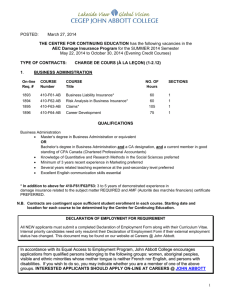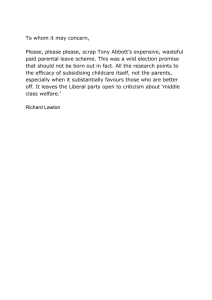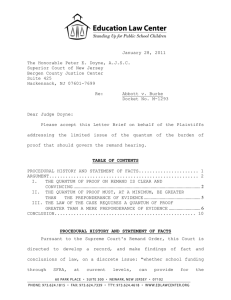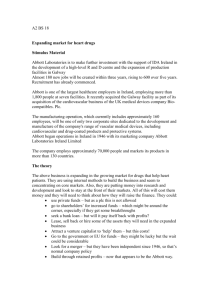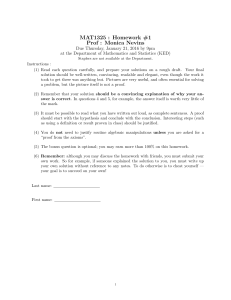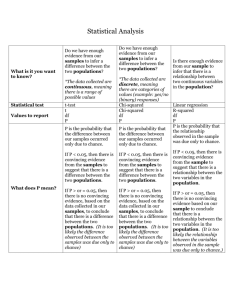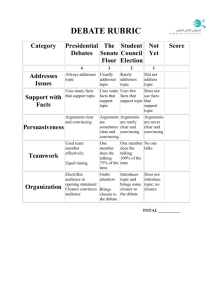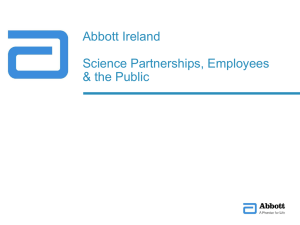Ltr Brief Burden of - Education Law Center
advertisement
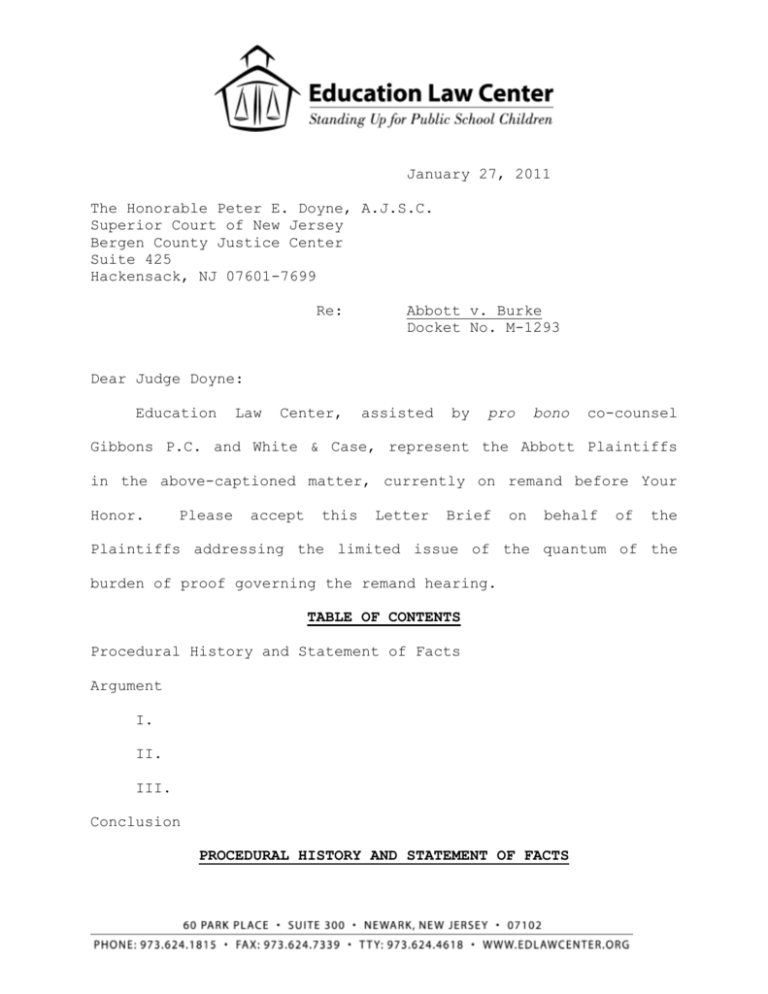
January 27, 2011 The Honorable Peter E. Doyne, A.J.S.C. Superior Court of New Jersey Bergen County Justice Center Suite 425 Hackensack, NJ 07601-7699 Re: Abbott v. Burke Docket No. M-1293 Dear Judge Doyne: Education Law Center, assisted by pro bono co-counsel Gibbons P.C. and White & Case, represent the Abbott Plaintiffs in the above-captioned matter, currently on remand before Your Honor. Please accept this Letter Brief on behalf of the Plaintiffs addressing the limited issue of the quantum of the burden of proof governing the remand hearing. TABLE OF CONTENTS Procedural History and Statement of Facts Argument I. II. III. Conclusion PROCEDURAL HISTORY AND STATEMENT OF FACTS Plaintiffs will provide a detailed Procedural History and Statement of Facts in their pre-trial brief. Pursuant to the January 13, 2011 Order of the Supreme Court of New Jersey, this matter is before this Court to create a record and to make proposed findings of fact and conclusions of law by conducting a hearing that "shall consider whether school funding through SFRA, at current levels, can provide for the constitutionally mandated thorough and efficient education for New Jersey school children." As directed by the Supreme Court, the State bears the burden of proof on remand, and this Court has asked the parties to address the quantum of proof by which the State must satisfy its burden. I. THE QUANTUM OF THE STATE’S BURDEN OF PROOF ON REMAND IS CLEAR AND CONVINCING EVIDENCE As the Supreme Court made clear in Abbott XXI, the State “must bear the burden of demonstrating that the present level of school funding distributed through the SFRA formula can provide for a thorough and efficient education as measured by the comprehensive core curriculum standards in districts with high, medium and low concentrations of disadvantaged pupils. Abbott XXI, 2011 ????, at *?. As explained below, the “clear and 2 convincing” standard is the appropriate quantum of proof that the State must meet on remand.1 The “clear and convincing” standard is compelled in matters impacting fundamental constitutional entitlements since, as the Supreme Court has held, “proof by a lower standard will not serve to generate confidence in the ultimate factual determination.” Liberty Mut. Ins. Co. v. Land, 186 N.J. 163, 170 (2006)(quoting In re Polk License Revocation, 90 N.J. 550, 568 (1982)); Santosky v. Kramer, 455 U.S. 745, 756, 102 S. Ct. 1388, 1396, 71 L. Ed. 2d 599 (1982), (quoting Addington v. Texas, 441 U.S. 418, 424, (1979)(mandating 99 S. Ct. the clear 1804, and 1808, convincing 60 L. Ed. standard 2d 323 “when the individual interests at stake are both ‘particularly important’ and ‘more substantial than mere loss of money’”)). no case known to Plaintiffs has a court Indeed, in accepted the preponderance of evidence as the quantum of proof required in a case involving fundamental constitutional rights. In this litigation, Plaintiffs’ entitlement to a constitutional education, N.J. Const., art. VIII, § 4, is at stake, which is a fundamental right far more substantial than 1 The “clear and convincing” standard requires that the evidence be so clear, direct and weighty and convincing as to enable the fact finder to come to a clear conviction, without hesitancy, of the precise facts in issue. In re Subryan, 187 N.J. 139, 144 (2006); see also Estate of Ostlund v. Ostlund, 391 N.J.Super. 390, 400 (App. Div. 2007). 3 the loss of money. Levine v. State Dept. of Institutions and Agencies, 84 N.J. 234, 258 (1980); Robinson v. Cahill, 69 N.J. 133, 147 (1975) underscored (“Robinson the IV”). “particular In Abbott import” of II, a the Court constitutional education to Plaintiffs’ future life prospects: While education is largely absent from [Abbott schoolchildren’s] lives, we get some idea of what is present from the crime rate, disease rate, drug addiction rate, teenage pregnancy rate, and the unemployment rate. Without an effective education [the Abbott schoolchildren] are likely to remain enveloped in this environment. Their overall needs are not limited to education, but that need is overwhelming. [Id. at 391-92.] As the fundamental, right to and the a thorough need for and a efficient education constitutional is education “overwhelming,” the clear and convincing standard is thus the appropriate measure by which to determine whether the State has demonstrated that the present level of school funding distributed through the SFRA formula can provide for a thorough and efficient education. II. AT A MINIMUM, THE EVIDENTIARY STANDARD MUST BE CONVINCING, OR GREATER THAN A PREPONDERANCE OF THE EVIDENCE In addition “convincing,” to "clear “abiding and convincing," conviction” and the terms “convincingly demonstrate” have been employed by New Jersey state courts to 4 reflect the heavy burden that has been imposed in matters adjudicating constitutional rights. Wright v. Village of South Orange, 79 N.J. Super. 96, 105 (App. Div. 1963)(relying on “abiding conviction” standard when constitutional rights are at issue); Branzburg v. Hayes, 408 U.S. 665, 739-40, 92 S. Ct. 2646, 2679, 33 L. Ed. 2d 626 (1972) (Stewart, J., dissenting)(citing U.S. Supreme Court’s consistent holding when governmental that investigation government investigation sought”). implicates “‘convincingly’ is ‘substantially First Amendment demonstrate related’ to rights, that the the information See generally Davidson v. Fornicola, 38 N.J. Super. 365, 372 (App. Div. 1956) (describing the various formulations of this higher standard of proof used by courts over time, and their distinction from the preponderance of evidence standard). While Plaintiffs consider those formulations to be synonymous with “clear and convincing evidence,” they accept, in the alternative, this Court's view that "[a] 'convincing' standard requires higher a burden than probability." a greater simple than the probability preponderance but lower standard,… than a high Abbott v. Burke, 199 N.J. 140, 238 (2009)(quoting from the remand opinion of the Hon. Peter E. Doyne, A.J.S.C.). III. THE STATE MUST PROVE ITS CASE WITH CONVINCING EVIDENCE UNDER THE LAW OF THE CASE DOCTRINE 5 Even absent this backdrop of State and federal decisions, the Supreme Court’s pronouncements in prior Abbott decisions regarding the burden of proof on the State have established a "clear and convincing" evidentiary standard, or its equivalent, as "the law proceeding. of the case" that should govern this remand Under the “law of the case” doctrine, “when a court decides upon a rule of law, that decision should continue to govern the same issues in subsequent stages in the same case.” Arizona v. California, 460 U.S. 605, 618, 103 S.Ct. 1382, 75 L.Ed.2d 318 (1983). “Courts apply the law of the case doctrine when their prior decisions in an ongoing case either expressly resolved an issue or necessarily resolved it by implication.” United Artists Theatre Circuit, Inc. v. Township of Warrington, 316 F.3d 392, 398-99 (3d Cir.2003) (citation omitted) (emphasis added); see also In re City of Philadelphia Litig., 158 F.3d 711, 718 (3d Cir.1998) (same). In Abbott II, the Court specifically stated that it “would not strip all notions of equal and adequate funding from the constitutional that the State was clearly right.” 119 N.J. at 377 (emphasis added). In addition, the obligation Court unless expressly we held were in convinced Abbott IV that, with regard to replacing the parity amount for regular education with another base amount, the State must proffer “concrete” evidence to “convincingly demonstrate” that 6 any new, reduced amount assures Plaintiffs adequate funding to achieve state standards. Abbott IV, 149 N.J. at 196; see also Abbott XIX, 196 N.J. 544, 562(same). on a In Abbott XX, the Court not only based its holding record that "convincingly demonstrates that SFRA is designed to provide school districts in this state, including the Abbott school districts, with adequate resources to provide the necessary standards, educational 199 N.J. "explicit…insistence programs 140, that 147, if the consistent but also State with state reaffirmed could its convincingly demonstrate that a substantive thorough and efficient education can be achieved, Court-imposed remedies would no longer be needed, 199 N.J. at 163-64 [quotations omitted]." Thus, throughout the proceedings in this case, the Court has demonstrated its intent that a clear and convincing standard -- or at least a convincing standard -- be employed; without clear direction otherwise, this Court should not impose a lesser quantum of proof where the State has been given the burden of proving that "current underfunded levels" of school funding can nonetheless afford a constitutionally mandated thorough and efficient education to New Jersey's school children. CONCLUSION In sum, the clear and convincing standard, or at a minimum, a standard that exceeds the preponderance of the evidence, is compelled where, as here, the issue at stake is the State's 7 obligations regarding the fundamental educational rights of the Abbott school children. Respectfully submitted, David G. Sciarra, Esq. Attorney for Plaintiffs Encls. cc: Mark Neary, Clerk, NJ Supreme Court Jon Martin, DAG Lawrence S. Lustberg, Esq. John Rue, Esq. Counsel for Amici Curiae 8
